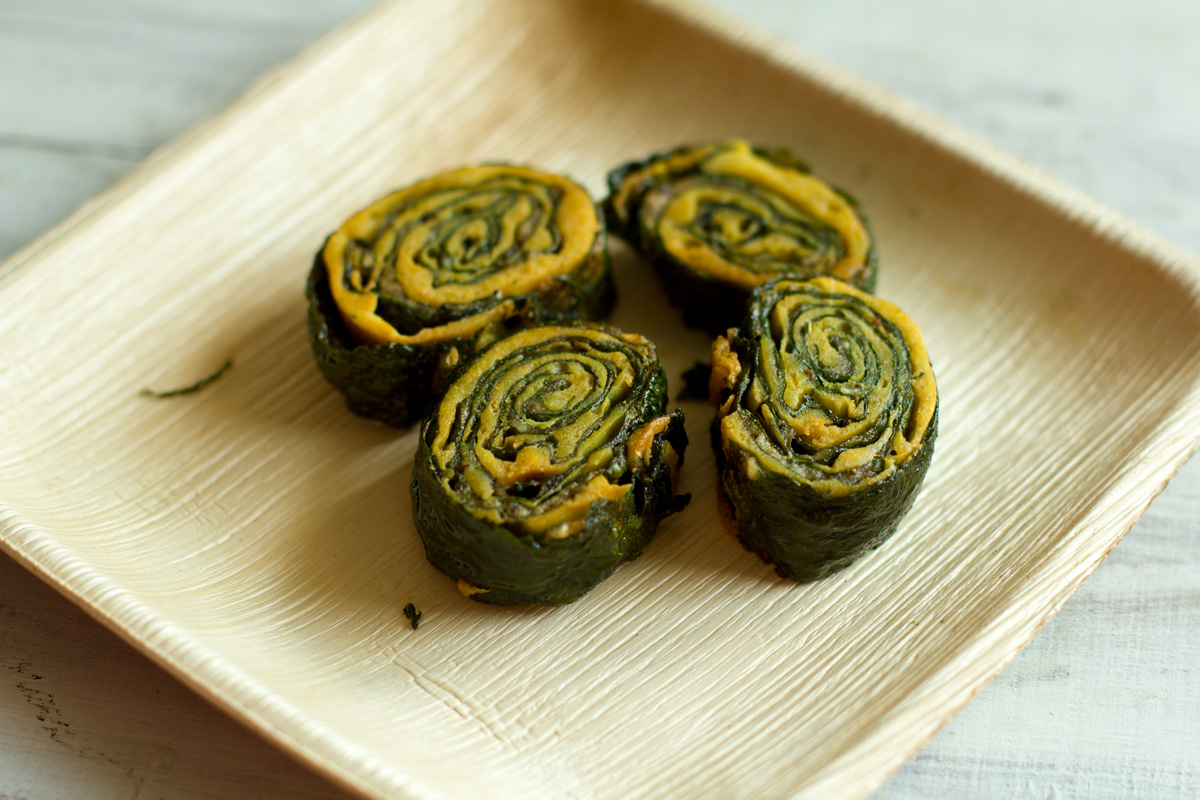Patra Recipe: Make delicious Patra (Alu Vadi) at home with colocasia leaves and spiced gram flour — steamed, sliced, and pan-fried to perfection!
Make authentic Gujarati Patra (Alu Vadi) in 5 easy steps! A crispy, tangy snack made with colocasia leaves and gram flour. Steamed and pan-fried to perfection.
🍃 Ingredients Table(Patra Recipe):
| Ingredient | Quantity |
|---|---|
| Colocasia (arbi) leaves | 6–8 large leaves |
| Besan (gram flour) | 1 cup |
| Tamarind pulp | 2 tbsp |
| Jaggery (grated) | 1 tbsp |
| Red chili powder | 1 tsp |
| Turmeric powder | ½ tsp |
| Coriander powder | 1 tsp |
| Hing (asafoetida) | A pinch |
| Salt | To taste |
| Sesame seeds | 1 tsp (for garnish) |
| Oil | For tempering |
| Water | As needed to make paste |
👨🍳 Recipe Steps(Patra Recipe) :
Prepare the Colocasia Leaves:
- Wash the colocasia leaves thoroughly under running water and pat them dry with a clean cloth.
- Lay each leaf flat with the vein side facing upwards. Using a sharp knife or scissors, carefully trim off the thick central stem and flatten the prominent side veins. This helps in rolling the leaves without tearing and prevents throat itchiness (which some colocasia varieties can cause).
Prepare the Besan Batter:
- In a large bowl, combine the besan (gram flour) with ginger-green chili paste, tamarind pulp, grated jaggery, and all the dry spices (turmeric, red chili, coriander, cumin, garam masala, asafoetida, and salt).
- Gradually add water, whisking continuously, to form a thick, smooth paste. The consistency should be thick enough to easily spread on the leaves without being too runny. Some recipes also add a little hot oil or a pinch of baking soda to the batter for a softer texture.
- Taste the batter and adjust the balance of sweet, sour, and spicy flavors as per your preference.
Layer and Spread the Leaves:
- On a clean, flat surface (like a large cutting board), lay the largest colocasia leaf with its dull side facing upwards and the tip pointing away from you.
- Spread a thin, even layer of the prepared besan batter over the entire surface of the leaf using your fingers or a spatula.
- Place the next largest leaf on top of the first, with its tip pointing in the opposite direction. Spread another thin layer of batter.
- Repeat this process, stacking about 3-5 leaves, depending on their size and your desired roll thickness. Ensure each leaf is well-coated with batter.
Fold and Roll the Patra:
- Once all leaves are stacked and coated, fold the sides of the layered leaves inwards (about 2 inches from each side) to create a rectangular shape. Apply a little batter on the folded edges to help them stick.
- Starting from the bottom (the wider end), tightly roll the layered leaves upwards into a firm cylindrical log. Apply a little batter on each fold to seal it as you roll. Ensure the roll is tight to prevent it from opening during steaming.
Steam the Patra Rolls:
- Grease a steamer plate or tray with a little oil.
- Carefully place the prepared patra rolls on the greased steamer plate.
- Heat water in a steamer pot or a large vessel. Once the water is boiling, place the steamer plate with the patra rolls inside.
- Cover and steam the rolls for about 15-25 minutes (timing can vary based on thickness), or until a knife inserted into the center comes out clean. The rolls will become firm and darker in color.
Cool and Slice:
- Once steamed, remove the patra rolls from the steamer and let them cool down completely. Cooling is crucial for neat slicing.
- Once cooled, cut the rolls into 1/2 to 1-inch thick slices.
Temper or Shallow Fry (Optional but Recommended):
- For Tempering (Tadka): Heat oil in a pan. Add mustard seeds and let them splutter. Then add sesame seeds, asafoetida, and curry leaves (if using). Sauté for a few seconds. Gently add the sliced patra pieces to the tempering and toss gently to coat. Cook for a minute or two until lightly heated through.
- For Crispy Patra: You can also shallow-fry the slices in a pan with a little oil until they turn golden brown and crispy on both sides.
Garnish and Serve:
- Garnish the tempered or fried patra with fresh coriander leaves and grated coconut (optional).
- Serve hot with green chutney, tamarind chutney, or as a snack with tea.
💡 Top Tips for Perfect Patra:
- Use fresh and tender colocasia leaves to avoid itchiness.
- Add tamarind + jaggery to balance flavors — Patra should be sweet, sour, and spicy.
- Always steam the rolls properly before slicing.
- To make it healthier, skip frying and just temper after steaming.
- Sprinkle sesame seeds and grated coconut before serving for extra taste.
❓ FAQs:
1. What is Patra made of?
Patra is made using colocasia leaves layered with a spiced gram flour paste, then rolled, steamed, and sometimes pan-fried.
2. What is Alu Vadi?
Alu Vadi is the Maharashtrian name for Patra — made the same way using arbi leaves.
3. Can I make Patra without steaming?
No, steaming is essential to cook the leaves and besan properly.
4. Why does Patra taste itchy?
This happens if colocasia leaves are not fresh or undercooked. Always steam well.
5. Is Patra good for health?
Yes! It’s high in fiber, iron, and protein (from besan), especially when pan-fried or air-fried.
6. How long can Patra be stored?
Up to 3 days in the fridge. Reheat in a pan or steamer.
7. Can I freeze Patra?
Yes, freeze the steamed rolls before slicing.
8. Can I use tamarind paste instead of pulp?
Yes, but dilute slightly and adjust for sweetness.
9. What do you serve Patra with?
Green chutney, tamarind chutney, or plain yogurt.
10. Is Patra vegan and gluten-free?
Yes, it’s naturally vegan and gluten-free!
11. Can I air-fry Patra instead of frying?
Yes! After steaming and slicing, air-fry at 180°C for 8–10 mins.
12. Is Patra served hot or cold?
Best enjoyed warm, but can be served cold as a snack too.
13. What if the batter is too runny?
Add a little more besan to thicken it.
14. Is this a festive recipe?
Yes, Patra is commonly made during Diwali and other Gujarati occasions.
15. Can I use spinach instead of colocasia leaves?
Not recommended — you won’t get the same structure or taste.
16. Can I make it without jaggery?
You can, but the traditional taste needs that sweet balance.
17. How do I avoid cracks while rolling?
Use large, soft leaves and don’t overfill the paste.
18. Can I prepare Patra ahead of time?
Yes. Steam, slice, and refrigerate. Temper before serving.
19. Is Patra kid-friendly?
Yes! Just adjust spice level and serve with a dip.
20. What is the meaning of Patra?
In Gujarati, “Patra” means “leaf” — referring to the colocasia leaf used.
21. How thick should the besan paste be?
It should be spreadable but thick enough to coat the leaf without dripping.Gujrati Best Recipes



“Thank you for this beautiful recipe! The flavors were spot on – sweet, tangy, and spicy. I added a bit of grated coconut in the tempering and it took it to the next level. Definitely bookmarking this one!”